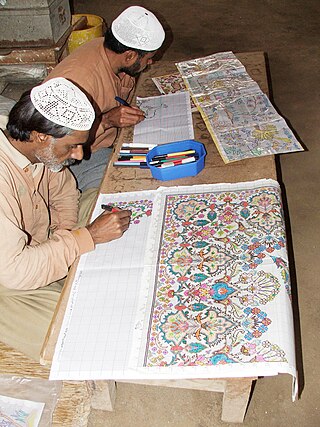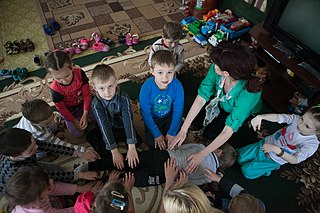Related Research Articles

Cognitive behavioral therapy (CBT) is a psycho-social intervention that aims to reduce symptoms of various mental health conditions, primarily depression and anxiety disorders. CBT focuses on challenging and changing cognitive distortions and their associated behaviors to improve emotional regulation and develop personal coping strategies that target solving current problems. Though it was originally designed to treat depression, its uses have been expanded to include the treatment of many mental health conditions, including anxiety, substance use disorders, marital problems, and eating disorders. CBT includes a number of cognitive or behavioral psychotherapies that treat defined psychopathologies using evidence-based techniques and strategies.

Psychotherapy is the use of psychological methods, particularly when based on regular personal interaction, to help a person change behavior, increase happiness, and overcome problems. Psychotherapy aims to improve an individual's well-being and mental health, to resolve or mitigate troublesome behaviors, beliefs, compulsions, thoughts, or emotions, and to improve relationships and social skills. Numerous types of psychotherapy have been designed either for individual adults, families, or children and adolescents. Certain types of psychotherapy are considered evidence-based for treating some diagnosed mental disorders; other types have been criticized as pseudoscience.
Group psychotherapy or group therapy is a form of psychotherapy in which one or more therapists treat a small group of clients together as a group. The term can legitimately refer to any form of psychotherapy when delivered in a group format, including art therapy, cognitive behavioral therapy or interpersonal therapy, but it is usually applied to psychodynamic group therapy where the group context and group process is explicitly utilized as a mechanism of change by developing, exploring and examining interpersonal relationships within the group.

Music therapy, an allied health profession, "is the clinical and evidence-based use of music interventions to accomplish individualized goals within a therapeutic relationship by a credentialed professional who has completed an approved music therapy program."

Humanistic psychology is a psychological perspective that arose in the mid-20th century in answer to two theories: Sigmund Freud's psychoanalytic theory and B. F. Skinner's behaviorism. Thus, Abraham Maslow established the need for a "third force" in psychology. The school of thought of humanistic psychology gained traction due to key figure Abraham Maslow in the 1950s during the time of the humanistic movement. It was made popular in the 1950s by the process of realizing and expressing one's own capabilities and creativity.

Occupational therapy (OT) is a healthcare profession. It involves the use of assessment and intervention to develop, recover, or maintain the meaningful activities, or occupations, of individuals, groups, or communities. The field of OT consists of health care practitioners trained and educated to improve mental and physical performance. Occupational therapists specialize in teaching, educating, and supporting participation in any activity that occupies an individual's time. It is an independent health profession sometimes categorized as an allied health profession and consists of occupational therapists (OTs) and occupational therapy assistants (OTAs). While OTs and OTAs have different roles, they both work with people who want to improve their mental and or physical health, disabilities, injuries, or impairments.
Dance/movement therapy (DMT) in USA/ Australia or dance movement psychotherapy (DMP) in the UK is the psychotherapeutic use of movement and dance to support intellectual, emotional, and motor functions of the body. As a modality of the creative arts therapies, DMT looks at the correlation between movement and emotion.

Psychodrama is an action method, often used as a psychotherapy, in which clients use spontaneous dramatization, role playing, and dramatic self-presentation to investigate and gain insight into their lives.
Sex therapy is a strategy for the improvement of sexual function and treatment of sexual dysfunction. This includes sexual dysfunctions such as premature ejaculation or delayed ejaculation, erectile dysfunction, lack of sexual interest or arousal, and painful sex, as well as dealing with problems imposed by atypical sexual interests (paraphilias), gender dysphoria and being transgender, highly overactive libido or hypersexuality, a lack of sexual confidence, recovering from sexual abuse such as rape or sexual assault, and sexual issues related to aging, illness, or disability.
The expressive therapies are the use of the creative arts as a form of therapy, including the distinct disciplines expressive arts therapy and the creative arts therapies. The expressive therapies are based on the assumption that people can heal through the various forms of creative expression. Expressive therapists share the belief that through creative expression and the tapping of the imagination, people can examine their body, feelings, emotions, and thought process.

Art therapy is a distinct discipline that incorporates creative methods of expression through visual art media. Art therapy, as a creative arts therapy profession, originated in the fields of art and psychotherapy and may vary in definition.

Play therapy refers to a range of methods of capitalising on children's natural urge to explore and harnessing it to meet and respond to the developmental and later also their mental health needs. It is also used for forensic or psychological assessment purposes where the individual is too young or too traumatised to give a verbal account of adverse, abusive or potentially criminal circumstances in their life.
Attachment therapy is a pseudoscientific child mental health intervention intended to treat attachment disorders. It is found primarily in the United States, and much of it is centered in about a dozen clinics in Evergreen, Colorado, where Foster Cline, one of the founders, established his clinic in the 1970s.

Autistic art is artwork created by autistic artists that captures or conveys a variety of autistic experiences. According to a 2021 article in Cognitive Processing, autistic artists with improved linguistic and communication skills often show a greater degree of originality and attention to detail than their neurotypical counterparts, with a positive correlation between artistic talent and high linguistic functioning. Autistic art is often considered outsider art. Art by autistic artists has long been shown in separate venues from artists without disabilities. The works of some autistic artists have featured in art publications and documentaries and been exhibited in mainstream galleries. Although autistic artists seldom received formal art education in the past, recent inclusivity initiatives have made it easier for autistic artists to get a formal college education. The Aspergers/Autism Network's AANE Artist Collaborative is an example of an art organization for autistic adults.
This article discusses occupational therapy (OT) in the United Kingdom.
The American Art Therapy Association (AATA) is a U.S. not-for-profit 501(c)(3), non-partisan national professional association of approximately 5,000 practicing art therapy professionals, including students, educators, and related practitioners in the field of art therapy based in Alexandria, VA. It establishes criteria for training and licensing of art therapists, maintains job banks, sponsors conferences, and publishes a newsletter and a journal Art Therapy: the journal of the American Art Therapy Association. Founded in 1969, the AATA is one of the world's leading art therapy membership organizations.

Edith Kramer (1916–2014) was an Austrian social realist painter, a follower of psychoanalytic theory and an art therapy pioneer.
Family therapy is a branch of psychology and clinical social work that works with families and couples in intimate relationships to nurture change and development. It tends to view change in terms of the systems of interaction between family members.
Barry Marc Cohen is an American art therapist, scholar, event producer, and art collector. He is known for his contribution to the theory and practice of art therapy, both in originating and researching a new assessment technique and in understanding the art of people diagnosed with dissociative disorders. These endeavors have garnered him awards from the American Art Therapy Association and the International Society for the Study of Trauma and Dissociation.
Film/video-based therapy involves making movies with clients. It draws from several disciplines from cinema therapy, expressive therapy, narrative therapy, art therapy, digital storytelling, and phototherapy which requires a collaboration to integrate the many dynamic aspects of art and medicine. Joshua Lee Cohen Ph.D., author and co-editor of Video and Filmmaking as Psychotherapy: Research and Practice, helped to establish a collaborative effort in forming film/video-based therapy. This form of therapy is about making films with clients, as opposed to cinema therapy, which involves watching films. Cohen has utilized watching films and mindfulness in his work. Cohen has been cited in Tuval-Mashiach and Patton's clinical trial and participated in peer reviewed research on the use of video narrative in cancer research. It is not trademarked for advertising or financial purposes but intended to protect the sanctity of the license for mental health professionals and the use of the word "therapy" when used in conjunction with film/video in the United States.
References
- 1 2 "Frances F. Kaplan | WorldCat.org". www.worldcat.org. Retrieved 2022-12-04.
- ↑ Kaplan, Frances Fisher (1976). Single-session art therapy with in-patient groups : determining effectiveness and developing an approach (Thesis). Pratt Institute, School of Art and Design.
- ↑ Bates, Todd (1983-08-19). "Carrier therapists pioneer new approach to using art". The Central New Jersey Home News. p. 18. Retrieved 2022-12-04.
- ↑ Kapitan, Lynn (2018-10-02). "In Memoriam: Dr. Frances F. Kaplan, Editor of Art Therapy (2001–2005)". Art Therapy. 35 (4): 218–220. doi: 10.1080/07421656.2018.1554036 . ISSN 0742-1656. S2CID 151267405.
- 1 2 "Art Therapy Today" (PDF). April 12, 2018. Archived from the original (PDF) on December 4, 2022. Retrieved 2022-12-04.
- ↑ Review for Art, Science and Art Therapy: Repainting the Picture
- Donaldson, Claire (2001). "Book Reviews". The Journal of the Royal Society for the Promotion of Health. Sage Publications Ltd. 121 (3): 199. doi:10.1177/146642400112100217. S2CID 57011689.
- Levick, Myra F. (May 2001). "Review: Art, Science and Art Therapy". American Journal of Art Therapy; Washington. 39 (4): 123 – via ProQuest.
- ↑ Reviews of Art Therapy and Social Action
- Acharya-Baskerville, Madi (May 2007). "Review: Art Therapy and Social Action". Mental Health Practice. 10 (8): 25. doi:10.7748/mhp.10.8.25.s22.
- "Review: Art therapy and social action". Scitech Book News; Portland. Vol. 31, no. 2. June 2007.
- Serlin, Ilene (2010). "Art Therapy and Social Action:Book review: (546022012-004)". doi:10.1037/e546022012-004.
{{cite journal}}: Cite journal requires|journal=(help)